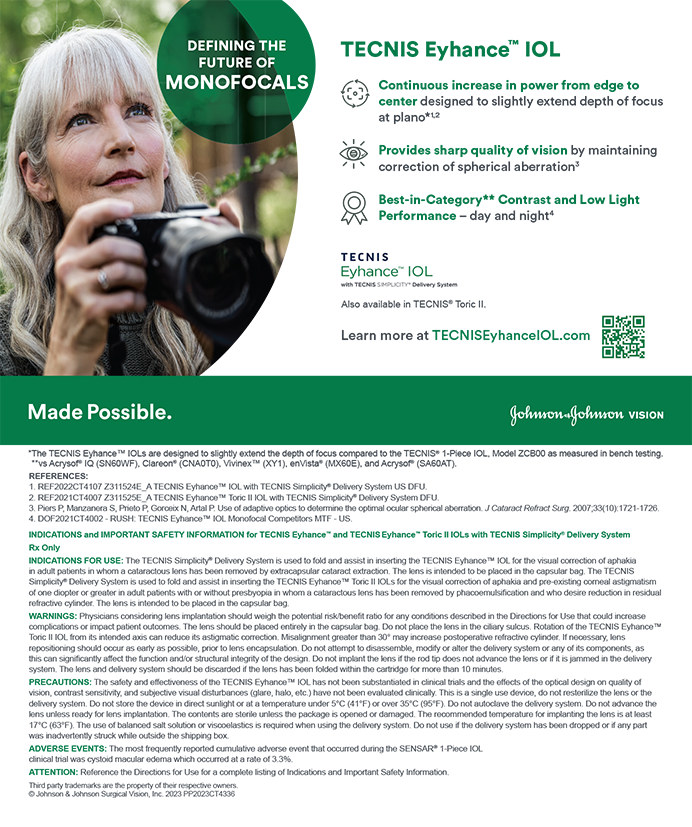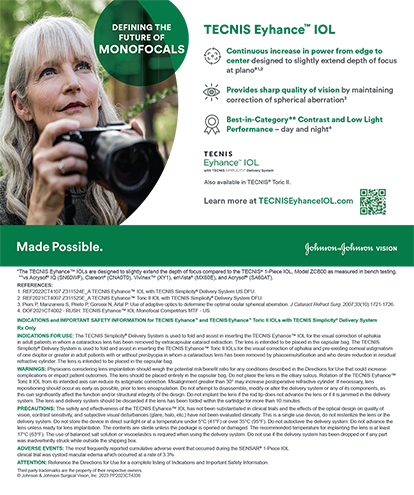The Modified Capsular Tension Ring (CTR) (Morcher GmbH, Stuttgart, Germany; distributed in the US by FCI Ophthalmics, Inc., Marshfield Hills, MA) is much like a standard CTR except for the fixation hook attached to the PMMA ring filament. As the device lies inside the capsular bag, this hook rests at a plane anterior to that of the ring so that the hook courses around the capsulorhexis' edge. Passing a suture through an eyelet located at the edge of the fixation hook fixes the ring to the scleral wall.The Modified CTR is indicated when a standard CTR will not provide sufficient stability to allow phacoemulsification and/or the long-term stability and centration of an IOL implant in the bag. Specifically, the device is appropriate in eyes with more than 180? of zonular dialysis and in cases of marked lens decentration (eg, from trauma or Marfan's syndrome). My advice for success with the Modified CTR follows.
TIMING
The Modified CTR may be placed into the capsular bag at any time after the creation of a continuous, anterior, curvilinear capsulorhexis. As with a standard CTR, the modified device is not appropriate if the capsulorhexis is not intact?for instance, due to a peripheral extension or capsular tear?because the expansile force of the ring can tear the bag further.
Trying to place the Modified CTR before removing the nucleus is challenging, although I have done so many times. The bulk of the nucleus makes it difficult to place the ring without stressing the residual zonules, and the debris in the capsular bag compromises visualization. My advice to surgeons unfamiliar with the device is not to place it until after removing the nucleus.
To stabilize the capsular bag after the capsulorhexis, I recommend grabbing the capsulorhexis' edge with a disposable nylon iris retractor much as one would catch iris tissue to expand a small pupil. This technique will hold the bag still for phacoemulsification.
INSERTING THE RING
After nuclear removal, I like to create a space for the Modified CTR by viscodissecting all of the cortex away from the periphery of the capsular bag. I prefer a dispersive viscoelastic for this maneuver, because some of the agent can ooze from the incision versus the expulsion of a cohesive glob. Before I place the ring in the bag, I preload the fixation hook's eyelet with a suture. I would recommend 9–0 Prolene (Ethicon Inc., Somerville, NJ) or 8–0 Gore-Tex (W.L. Gore & Associates, Inc., Newark, DE).
The Modified CTR is available in three versions. Model 1-L (Figure 1) must be inserted manually, so I use a tying forceps to feed the device into the bag so that the part closest to the fixation hook goes in last. During the insertion of the ring, the fixation hook should catch naturally anterior to the capsulorhexis' edge. If not, the surgeon must manipulate it anteriorly.
The model 2-C is a mirror image of the 1-L, so it may be inserted with an injector (Geuder AG, Heidelberg, Germany; distributed in the US by FCI Ophthalmics, Inc.). I feed the Modified CTR into the injector just up to the point of the fixation hook and then place the shooter through the incision.
The 2-L model has two fixation hooks and is indicated for extremely loose lenses. This is the most difficult version of the Modified CTR to use. I would recommend that surgeons first become familiar with suturing a one-hook model in a few less difficult cases before attempting to use the 2-L.
ORIENTING AND SECURING THE RING
With the Modified CTR in the bag, the next step is to dial the device so that the fixation hook is at the central part of the zonular dialysis. I then use a Sinskey or Y hook to push the device over to the scleral wall in order to determine where the ring should be sutured to center the bag well. I perform a conjunctival peritomy and make a partial-thickness scleral flap at that site.
Next, the needles are passed behind the posterior surface of the iris and in front of the anterior capsule so that they come out through the ciliary body and scleral wall, underneath the scleral flap. I tie them just tightly enough to ensure centration. It is somewhat difficult to bury the knot, which is why I place it under a scleral flap.Right before placing the IOL, I will inject a cohesive viscoelastic.
CONCLUSION
The availability of the CTR and now the Modified CTR has greatly enhanced cataract surgeons' ability to manage challenging cases. Videos demonstrating the use of the Modified CTR may be found at the AAO's Web site as well as at http://www.fci-ophthalmics.com/videos/cionni_ctr_video.htm.
Robert J. Cionni, MD, is Medical Director of the Cincinnati Eye Institute in Ohio. He has a financial interest in the Modified CTR device. Dr. Cionni may be reached at (513) 984-5133; rcionni@cincinnatieye.com.


